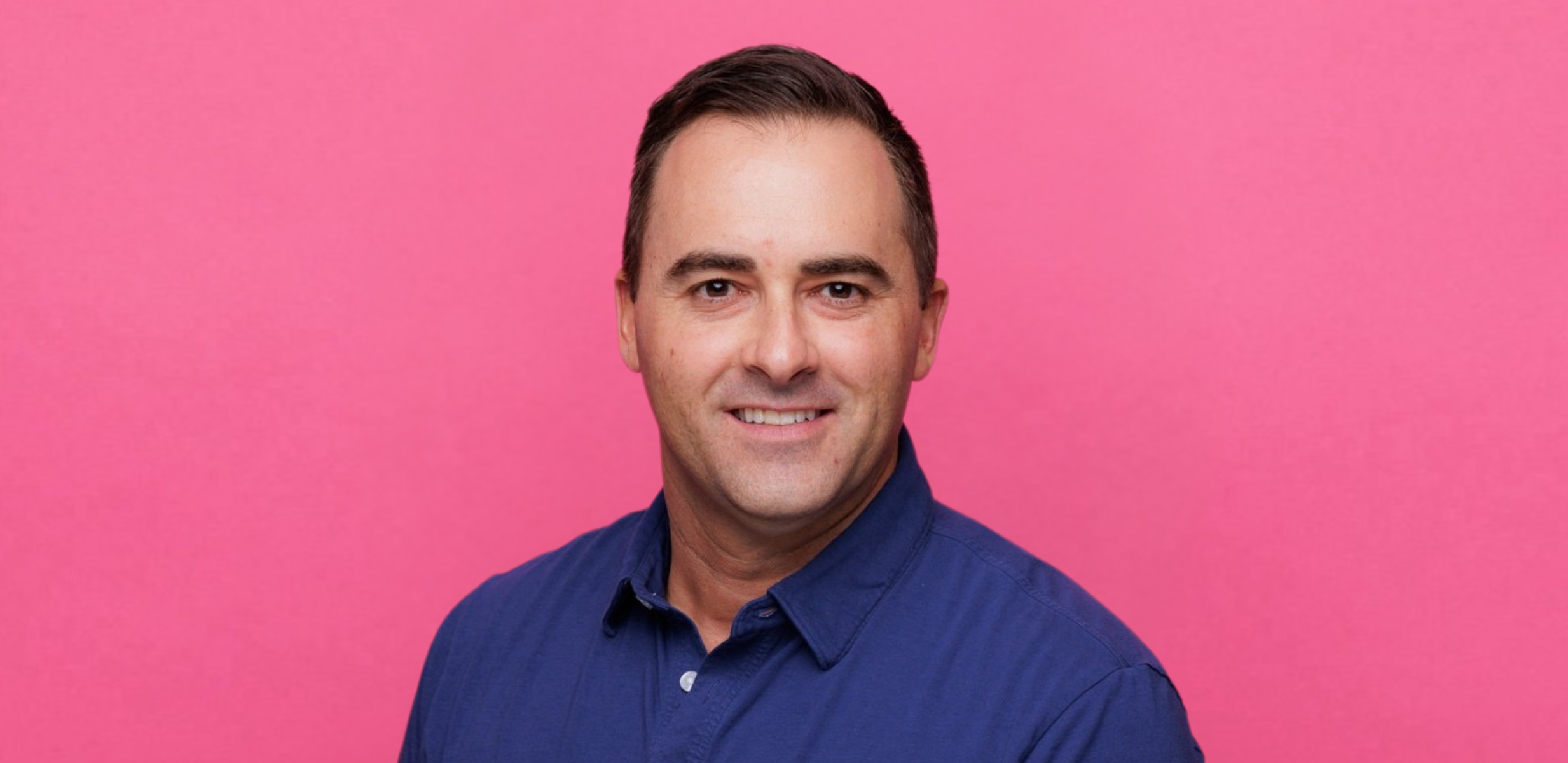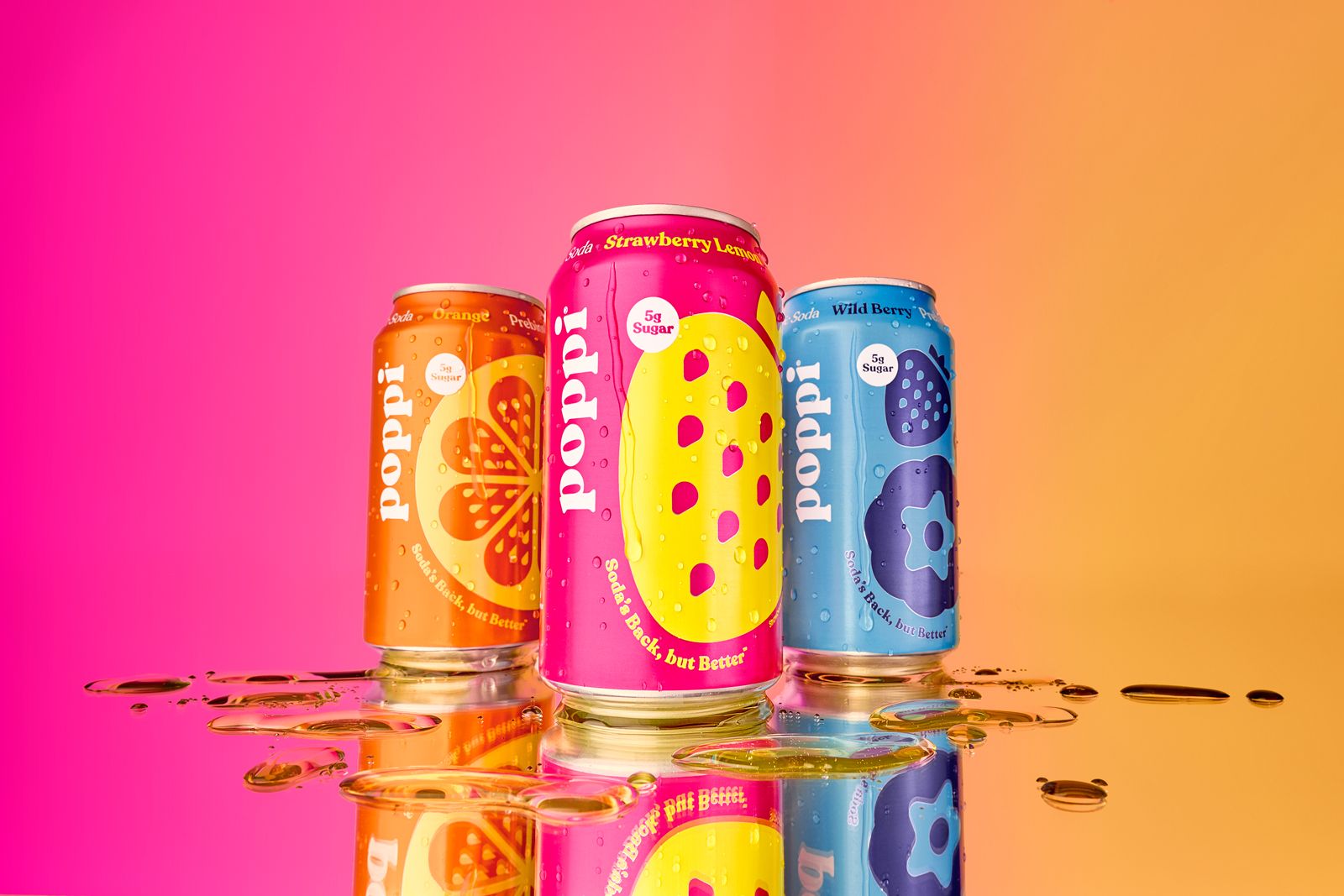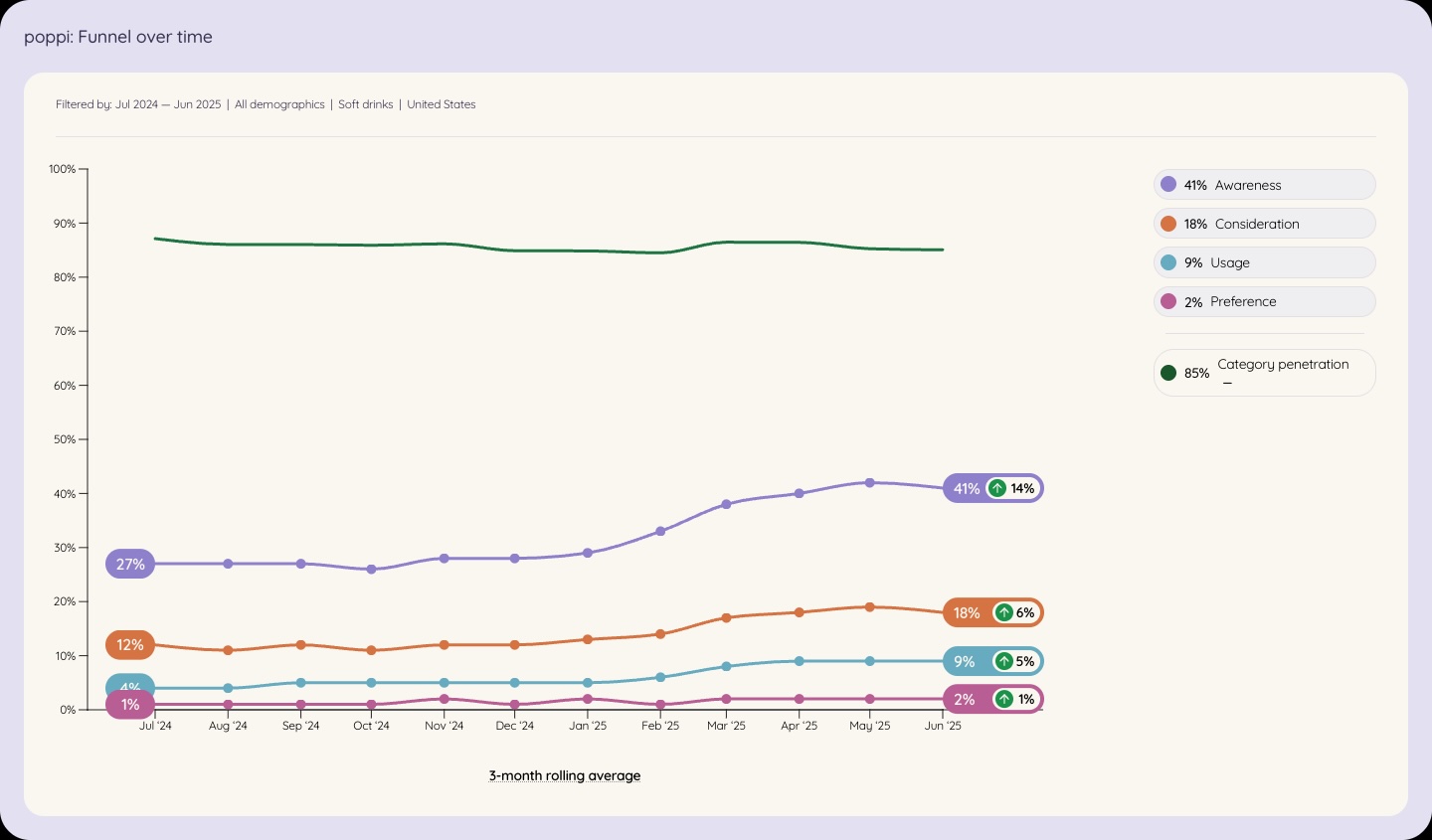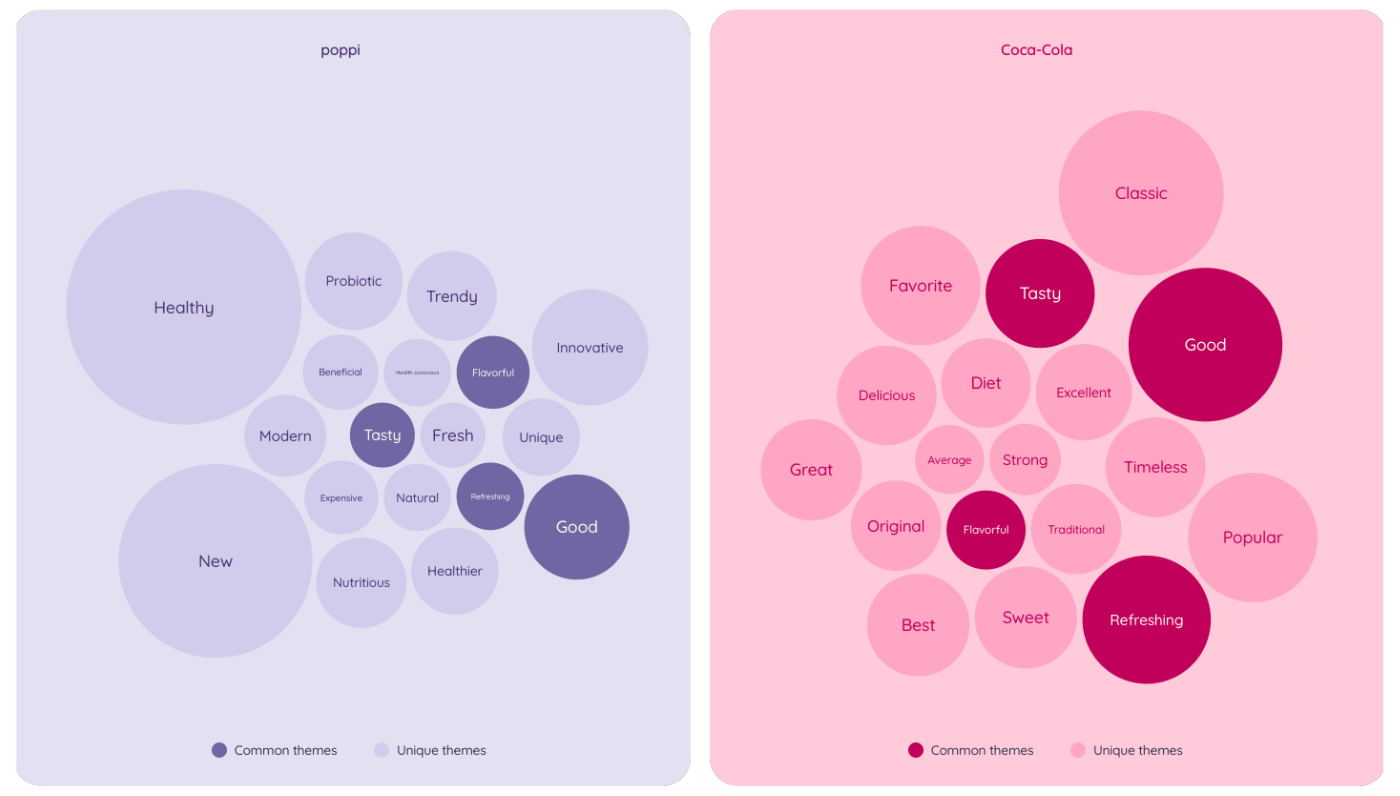
In partnership with Tracksuit. Data provided by Tracksuit; interview and analysis led independently by THE GOODS.
TL;DR: Poppi is rewriting the rules of shelf presence, and Matt Giese, Sr. Director of Retail Marketing and Partnerships, is doing it with strategy, humility, and a quiet obsession with miniature dioramas. In this edition of The Ritual of Retail, we break down how a gut-health home remedy became a billion-dollar disruptor. Now under PepsiCo and led at retail by Giese, Poppi is proving that the future of functional beverages isn’t built in boardrooms, it’s won at the shelf. Along the way: vacuum purchases, feedback that stings, and the joy of seeing the world through your kids’ eyes.
TEXAS—Ask a supermarket assistant where Poppi is today, and they’ll point you to aisle 12. Five years ago? You’d have gotten a blank stare and a tannoy announcement.
Starting life in a kitchen as a gut-health fix, Poppi is the functional soda brand launched in 2018 by Allison and Stephen Ellsworth. By 2025, the indie darling had scaled into a category catalyst compelling enough for PepsiCo to acquire for $1.95 billion. Shortly after, Pepsi introduced its own prebiotic cola, quietly affirming Poppi’s role as the category’s pace-setter.
Fred Hart, CPG Strategist, framed it best: “Pepsi didn’t just validate the category. They bet their flagship on it. That’s not chasing a trend, it’s repositioning a system.”
Poppi didn’t start with a whiteboard or a roadmap. It started with a gut feeling, literally. Pregnant and in discomfort, Allison Ellsworth began mixing apple cider vinegar with fruit and herbs in her kitchen. The result was oddly addictive.
At farmers markets, people kept coming back. Then a Whole Foods buyer took a sip and said, "You need to be in stores."
Before it had a name, Poppi had an effect. It wasn’t a tonic. It wasn’t a cleanse. It felt like soda, just one that didn’t betray you after lunch. That clarity helped shape the pitch on Shark Tank.
Although one investor passed, another, Rohan Oza (known for early bets on Vitaminwater and Smartwater) offered $400,000 for 25% equity. More than capital, it gave the brand insulation: a cultural operator who understood how to move product and perception.
Source: Tracksuit
Poppi is currently outperforming the “Better-for-You Soda” category on most fronts.
In the broader soda category, dominated by legacy players, Poppi still commands 40% awareness. It’s not yet a household name, but it’s already a household disruptor.

Driving retail strategy at Poppi is Matt Giese, Senior Director of Retail Marketing. A former Michelob ULTRA and Keurig Dr Pepper strategist, he’s now shaping how one of the most-watched beverage brands shows up on the shelf, and scales without dilution.
Giese, like every other marketer, knows firsthand how slippery brand loyalty can be. “I don’t think I ever turn the marketing brain off,” he says, half-laughing. “Even when I try.”
He tells the story of replacing his vacuum. “I’d been loyal to Dyson for years. But when it broke, I started comparing: Google, ChatGPT, YouTube. I found an entire channel dedicated to handheld vacuums.”
Eventually, he chose a Shark.
“The functionality felt better. The price was better. And at this stage of life, I value that more than sleek design or legacy loyalty.”
Then came the realisation: “I’d just become someone else’s conversion. A retail director somewhere is going to put that metric in a Q3 report. And it’s me.”
In that one-hour purchase window, he became the consumer he spends his days trying to understand.
Early in his career, a moment of recognition nearly became a blind spot. After winning “Person of the Year” at his agency, Giese admits he started showing up with a little too much certainty. “I lost sight of the fundamentals that got me there, being grounded in insights, listening, having empathy,” he says. A frank conversation with his manager was the reset. “It reminded me success isn’t about having the answer first, it’s about staying anchored to how you get there.”
Poppi’s retail philosophy balances intention with flexibility. “We don’t control the environment like DTC brands do,” says Giese. “So our job is to bring as much of that Poppi magic into the aisle as possible, through signage, storytelling, and experiences that sit right next to the product.”
He cites a collaboration with Target, nearly 20 pieces of branded merch rolled out nationally. “If you looked at just our merch sales during that period, we would’ve been a top 10 soda brand.”
A Minecraft Movie partnership soon followed: limited-edition packaging with a simple reward mechanic. Buy a four-pack, get a movie ticket. “It’s about blending what makes Poppi distinctive with big retail moments that broaden our reach.”
In February 2025, Poppi’s Super Bowl campaign placed branded vending machines in creators’ homes. The idea? Turn cultural attention into trial during soda’s seasonal peak. It worked—but not without blowback. Critics called out the campaign’s exclusivity and missed opportunities for broader reach. Within days, founder Allison Ellsworth responded, promising future placements in public venues and campuses.
Poppi has also faced scrutiny for its gut health claims. In May, its former parent company settled an $8.9 million class-action lawsuit alleging its packaging overstated the benefits of inulin. While denying wrongdoing, the company settled to avoid prolonged litigation.
In today’s retail landscape, placement is performance, and perception. For brands at scale, the work isn’t just standing out. It’s standing up when the spotlight turns sharp.
Matt Giese isn’t a founder, but he sounds like one. Ask him who shaped the way he leads, and he won’t name a CPG executive. He’ll describe three people from a small town in Texas: his mother, who went to law school while raising kids; his father, who worked shifts at a power plant; and his grandfather, who was a high school principal for 30 years.
“With all of them, it’s not really career-specific,” he says. “It’s more about: Are you a good person? Do you lead your team the right way? Do you make the right decisions? Are you fulfilled and happy with what you’re doing? I think those are the things they’d say matter most.”
That lens, character before category, is central to how Giese approaches Poppi’s voice at retail. And it’s shaped by early lessons in brand stewardship, long before functional soda was a thing.
“I started out in the agency world, and one of the first clients I had was Jack Daniel’s,” he says. “Everyone that worked on it saw themselves as stewards of this amazing, 150-year-old brand. They did a great job of taking authentic stories and moments from the early days and curating them into distinctive elements that felt both modern and timeless. That approach, how they connected with consumers, had a big impact on me. It’s stayed with me throughout my career.”
Today, that same mindset is guiding Poppi through its post-acquisition phase, navigating scale without sacrificing specificity.

Poppi may have launched on a gut health promise, but its staying power is built on flavour.
“It started with Allison and her personal needs, wanting a better solution from a gut health standpoint. That was our point of difference when entering this very mature, crowded soda category,” Giese explains. “But when you think about why people choose soda, and beverages overall, it often comes down to taste, refreshment, emotional connection. We have to deliver on all of that.”
He’s not guessing. Tracksuit data shows taste as one of the strongest levers for top and bottom-of-funnel conversion in the better-for-you soda category. Among aware consumers, those who associate a brand with “tastes great” are 2.1x more likely to consider it. Among considerers, that same association makes them 1.5x more likely to prefer the brand.
Poppi already shows strong conversion, outperforming competitor averages. The opportunity is to move taste to the centre of the storytelling, not just the label.
“Different consumers think about the brand, and buy it, for different reasons,” Giese says. “Different cohorts might overindex or underindex on certain components, but from a messaging standpoint, we try to stay true to the fun of the brand, and the better-for-you angle.”
With increased scrutiny across the wellness category, Poppi has shifted how it frames value. The emphasis now sits less on functional claims and more on clarity: flavour, relevance, and brand experience.
“We’re always thinking about how to stay true to the brand’s personality while meeting consumers where they are,” says Giese. “Sometimes people discover Poppi for gut health. Other times, it’s just because it’s fun and tastes good.”
That breadth of appeal has become a strategic strength, especially as expectations around transparency and trust continue to rise. “You’ll continue to see us focus our messaging around the fun and joy of soda,” he adds. “It’s really about clarity, delivering our value proposition in a simple, clean way.”
Recent brand tracking supports the shift. According to Tracksuit, Poppi has a 75% top-of-funnel conversion rate within the better-for-you soda category, 7 points above the category average. But there’s still room to deepen engagement, with 42% of those aware of the brand say they know it well.
That familiarity matters. Consumers who feel they know Poppi “very well” are 2.5x more likely to consider it.

Giese’s view of brand building is neither nostalgic nor overly technical. It sits somewhere in between, a blend of logic, empathy, and creative restraint.
“What has always fascinated me about marketing is the blend of art and science needed to accomplish whatever it is you’re trying to do,” he says. “It’s because people are inherently rational at times and irrational at others. We all make decisions with some combination of our heart and our minds.”
If he could capture one behavioural metric that escapes modern retail?
“I’ll aim high, how about a magical metric that can truly attribute all the impactful elements that went into that individual purchase,” he says. “Not what a consumer might tell us in a focus group or panel survey, not what we conclude from syndicated retail data, or an assumption from a pricing action or retail display, but a true attribution of purchase.”
He stops for a moment, then adds: “Maybe one day. But then perhaps that takes away some of the mystery and challenge of it all.”
Since Poppi’s $1.95B acquisition, Pepsi has largely taken a hands-off approach. But that doesn’t mean the relationship is passive.
“Pepsi has made it clear to us that they want the rebel. They want Poppi to continue being Poppi,” Giese says. “I anticipate there will be times where our way of doing things will not fully align with Pepsi’s established processes and approaches. As those happen, it will be important for our rebels to be in the room, literally, to articulate our perspective and fight for it when needed.”
Still, he’s pragmatic. “We recognize Pepsi is a world-class CPG organization that has built dozens of billion-dollar brands. We need and value their expertise, resources, and teams to scale Poppi, enabling us to reach more people in more places, more often.”
The challenge is pace and protection.
Outside the office, Giese’s curiosity shifts lanes. “So much weird stuff finds me, it’s probably just how the algorithm works,” he says, laughing. Lately, he’s been captivated by videos of people building miniature worlds inside walls or boxes. “The creativity is incredible. And then you realize, once something like that gets popular, it becomes this hyper-competitive space. Some are probably trying to monetize it.” It’s not about productivity, though. “It’s just a fun distraction. Something to marvel at.”
When it comes to ambition, Giese’s current bucket list isn’t packed with personal goals. “Right now, I’m really focused on experiencing things through my kids’ eyes, watching them have those first-time moments.” One day, maybe it’ll be a safari or a trip to Japan. But for now, he’s more drawn to the everyday kind of awe.
And if stranded on a desert island? No playlists or journals, just an axe, clean water, and fire. “I’d be focused on getting off that island. Survival first.” As for collaboration, he gives credit where it’s due. “We do most of our work internally at Poppi, but our teams constantly surprise me,” he says. “They’re part of the same community we market to, which gives them this incredible instinct for what will resonate, whether it’s a quick post or a 360 campaign. I should probably stop being surprised at this point.”

Poppi didn’t start with mass distribution. It started with farmers markets and a story.
But over time, it’s proven that clarity and consistency, executed well, can outperform size. Tracksuit’s data shows the brand has momentum and awareness continues to rise as does preference. For brand leaders, the lesson is this:
Start narrow. Get known for something. Make it taste good.
Then layer in structure and expand awareness. And when the scale comes, make sure your rebels are still in the room.
Poppi isn’t small anymore. But it still walks into rooms like it has something to prove. The question is: can you stay a rebel when the system starts dressing like you?